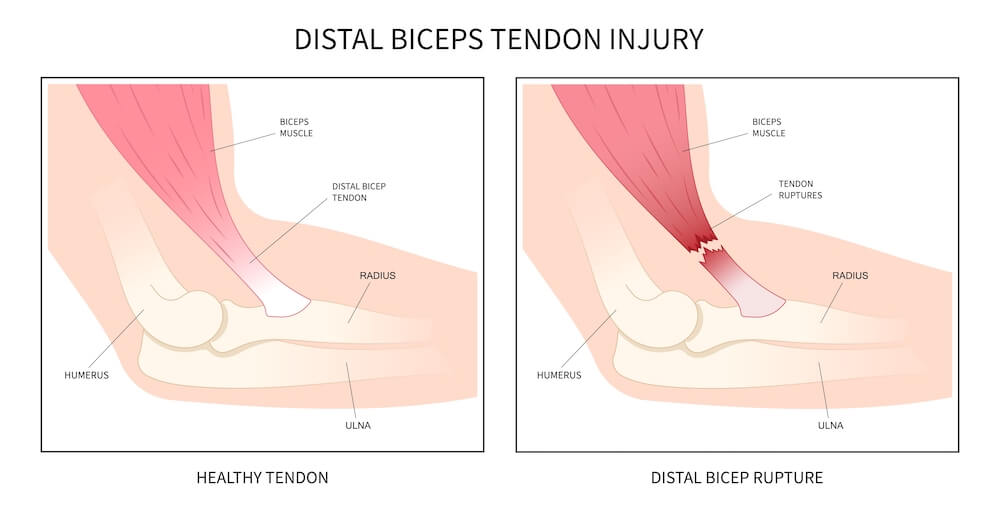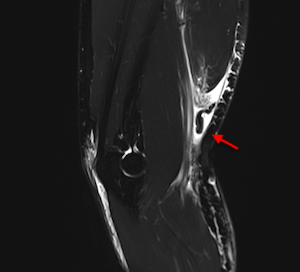Georgios Panagopoulos MD | Orthopaedic Surgeon

Η ρήξη καταφυτικού τένοντα δικεφάλου είναι η αποκόλληση του τένοντα από την κατάφυσή του στο οστό στο εγγύς άκρο της κερκίδας, κοντά στον αγκώνα. Η κάκωση είναι πιο συχνή σε άνδρες 30-50 ετών. Στις περισσότερες περιπτώσεις συνιστάται η χειρουργική θεραπεία.
Table of contents
What is a distal biceps tendon rupture?
Η ρήξη καταφυτικού τένοντα δικεφάλου είναι η αποκόλληση του τένοντα από την κατάφυσή του στο οστό στο εγγύς άκρο της κερκίδας, κοντά στον αγκώνα (κερκιδικό όγκωμα). Η κάκωση αυτή λαμβάνει χώρα συνήθως σε άνδρες ασθενείς μεταξύ 30-50 ετών και σχετίζεται με άθληση (ανύψωση βαρών) ή βαριά χειρωνακτική εργασία. Συνήθως η ρήξη είναι πλήρης, αν και σε μερικές περιπτώσεις μπορεί να υπάρχει μερική ρήξη τένοντα δικεφάλου.

What causes a rupture of the distal biceps?
Distal biceps ruptures tend to occur in the dominant elbow of men (>90%) around their 40s. The mechanism of rupture usually includes excessive eccentric tension as the arm is forced from a flexed to an extended position (flexed elbow unexpectedly challenged). Risk factors include:
- Smoking (x7.5 increased risk)
- Anabolic steroids (muscle grows too quickly before tendon can catch up)

What are the symptoms?
Most patients feel a sudden pop or snap at the front of their elbow with immediate pain, and subsequent bruising and swelling. This typically happens after lifting or dropping a heavy load. You may feel weakness in bending the elbow or twisting the forearm. You may also notice an altered contour of the biceps muscle – the muscle belly will sit higher up in the arm (compared to opposite uninjured side). This is called the “reverse Popeye sign.” A ruptured distal biceps tendon is usually associated with 20-30% loss of flexion strength (bending the elbow) & 40-50% loss of supination strength (rotating the forearm, as when you use a screwdriver).
- Sudden snapping sound at the time of rupture
- Swelling & bruising
- Reduced supination strength
- Reverse Popeye sign

How is it diagnosed?
History and physical exam usually provide enough information for your doctor to make a diagnosis of a distal biceps tendon rupture. Dr Panagopoulos may order an MRI or ultrasound to confirm the diagnosis and assess for tendon retraction or for partial ruptures, which are also possible.

Conservative treatment
It is not mandatory for every ruptured tendon to be repaired. You can live with your ruptured distal biceps tendon. You should expect 20-30% loss of flexion strength (bending the elbow) & 40-50% loss of supination strength (rotating the forearm, as when you use a screwdriver). If you have a low-demand job and lifestyle, you may manage well without surgery. However, if you have injured your dominant arm and engage in an active lifestyle, it is likely you will do better with surgery.
Surgical Treatment
Most active working-aged patients will choose to have distal biceps repair surgery to restore function if their tendon is fully torn. Surgery to repair the tendon should be performed during the few weeks after injury. After this time, the tendon and biceps muscle begin to scar and shorten. Further delay may preclude a straightforward, primary repair. In chronic cases, a more extensile approach may be required to retrieve the retracted and scarred distal biceps tendon. Use of an allograft may also be needed.
Dr Panagopoulos uses a small incision to allow the most anatomical repair, restoring near to normal function. A 3-cm incision is made in the elbow crease at the front of your arm. The ruptured tendon is retrieved. Sutures are then woven up and down the tendon and used to re-attach the tendon to the bone (radial tuberosity). A drill hole is made in the radial tuberosity and the biceps is then pulled through the drill hole with an adjustable button and secured in its anatomical position. The surgery generally takes about an hour. Your elbow is placed in a bandage and a sling to protect the repair. No plaster is necessary. This operation is typically performed as a day surgery and you can go home a few hours after the procedure. You can start moving your elbow the next day to prevent stiffness.
FAQs - Frequently Asked Questions
What is a distal biceps tendon rupture?
A distal biceps rupture occurs when the tendon attaching the biceps muscle to the biceps tuberosity at the elbow is torn from the bone.
Who is more susceptible?
Men between the ages of 30-50.
What's the usual mechanism of injury?
Hyperextension load on a flexed elbow.
What are the symptoms?
– Elbow pain and snapping sensation at the time of the injury
– Swelling and bruising
– Reverse Popeye sign -> biceps muscle retracted superiorly
How is diagnosis made?
– History & clinical exam
– Ultrasound or MRI scan
What if I don't have surgery?
You will lose approximately 50% of supination strength and 20-30% of flexion strength.
How is surgery performed?
Το χειρουργείο περιλαμβάνει επανακαθήλωση του τένοντα του δικεφάλου στην ανατομική του θέση (κερκιδικό όγκωμα) με τη χρήση μεταλλικού κομβίου ή με άγκυρες.
Πως είναι η αποκατάσταση; Απαιτείται φυσικοθεραπεία;
Η αποκατάσταση είναι γρήγορη. Η φυσικοθεραπεία είναι σημαντική για την ανάκτηση του εύρους κίνησης και την ακόλουθη ενδυνάμωση.
Find us
Book an appointment with us today
